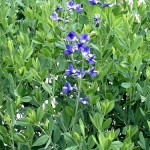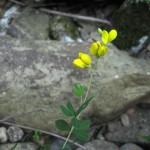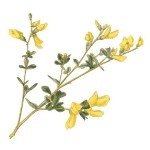Wild Indigo Root – Baptisia tinctoria
|
Current Demand = GOOD |
Parts Used: Root |
 |
 |
 |
 |
Family: Fabaceae (Pea)
Common Names: American indigo, baptisia,clover bloom, dyer’s baptisia, false indigo, horsefly weed, indigo broom, indigo weed, rattlebush, rattleweed, yellow broom, yellow indigo
Description:
Wild Indigo root is a perennial plant that grows up to 4 feet in height. The stem is erect, with slender branches that alternate. The leaves are grayish-green trilobar and contain several whorls of 3 clover like leaflets. The flowers grow at the top of the tallest branches, bluish purple, are hermaphrodite and bloom in July and August.
The roots have a thick knotty head with stem scars, and a round, fleshy root with rootlets up to 2 feet in length. The inside is white woody and the outside is thick dark brown, kind of scaly and dotted with small wart-like knobs. It has a bitter acrid taste and a faint odor.
Growing region: The wild indigo root can be found as far east as New Hampshire, south to Florida, west to Texas and north into Canada. It prefers dry soils in woods and clearings, along tree lines, open prairies or native hay fields.
Harvesting/Drying:
Parts Used: root
The stem and leaves may be gathered after the flowering is done. Gather the larger more mature plants leaving plenty of younger smaller plants to seed the area for future harvest. After harvest, remove all foreign matter (rocks, weeds and dirt) and spread in a thin layer immediately. The leaves and pods turn black upon drying. As the name might suggest the plant was used by the Cherokee to make a blue dye. When possible dry indoors in a well ventilated barn loft or attic to protect from the elements. If natural heat is not available you may need to add heat and a fan for continuous airflow.
You will need to turn or stir the leaf daily. Wild Indigo root should be harvested in the fall. After harvest remove any foreign matter. Spread the roots and turn daily to aid in drying. The key to drying any root, herb or bark is an even combination of heat and airflow. Never dry in an oven or microwave. The wild indigo be completely dry (largest root will snap not bend and the leaves will crush) in 3-7 days depending on the drying conditions. Once it is dried place the leaves and roots carefully into a cardboard boxes or paper bags for storage in a dry area until you are ready to sell or use. Never store wild indigo in plastic or it will mold.
Cultivation/Planting
The plant prefers light sandy, medium, loamy soils and requires well-drained soil. The plant prefers acid and neutral soils. It cannot grow in the shade. It requires dry or moist soil.
Propagation Seed: Seed are best sown as soon as it is ripe in a cold frame. Stored seed should be pre-soaked for 24 hours in warm water and then sown in a cold frame in late winter or early spring. Prick out the seedlings into individual pots as soon as they are large enough to handle and plant them out into their permanent positions in the summer or following spring.
Division: Larger divisions can be planted straight into their permanent positions. Smaller clumps are best potted up and kept in a cold frame until they are well established, then transplant to permanent homes. As a reminder, these plants have a very deep root system and dislike disturbances. So once they are well established do not disturb the soil.
Attributes (Images)
By Mason Brock (Masebrock) (Own work) [Public domain], via Wikimedia Commons
”Baptisia tinctoria” 17 juin 2006 Vieux jardin botanique de Göttingen
 Root Buyer
Root Buyer